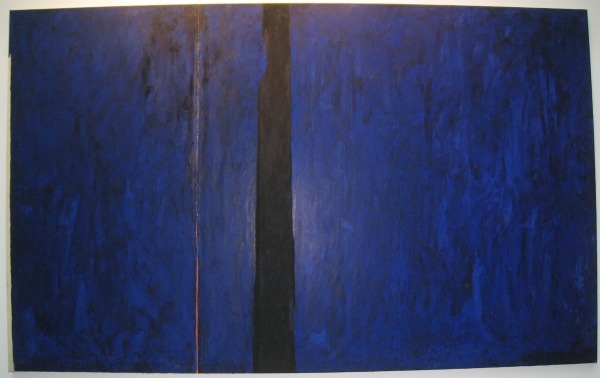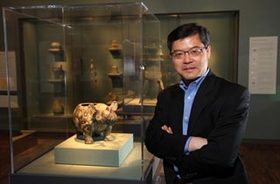 All that is behind the museum now. In fact, last September it re-launched with a new logo (which requires an explanation, alas) and a new mission, as covered in The New York Times. And it has been acquiring works, one outlined here.
All that is behind the museum now. In fact, last September it re-launched with a new logo (which requires an explanation, alas) and a new mission, as covered in The New York Times. And it has been acquiring works, one outlined here.
It seemed time to check in with the museum’s director, Jay Xu, who was hired in 2008. A native of Shanghai, Xu became curator of Asian Art at the Art Institute of Chicago in 2003, after heading the Seattle Museum’s department of Asian art and serving as curator of Chinese art theres for seven years. He also worked at the Shanghai Museum, and earned a master’s degree in art history from Princeton and worked as a fellow in Asian art at New York’s Metropolitan Museum of Art.
Earlier this month, I sent him Five Questions – here are his repsonses.
1) 2011 was supposed to be fresh start for the museum, a reinvention with new branding to reach new audiences: it’s early days, but given attendance so far, will the 2011-2012 attendance number be closer to the 187,000 last year or the 300,000 average?
We plan to be above 200,000, which, according to benchmark data from AAMD, is relatively high compared to museums of similar budget and exhibition space. In our case, lower attendance over the past 18 months is a result of reducing the number of exhibitions. We chose to emphasize unique, first-of-their-kind exhibitions (Shanghai, 2010; Bali, 2011; Maharaja, currently), and have them on view for a longer period, in order to maintain a balanced budget during the economic downturn. If you present a third fewer major exhibitions per year, you’re naturally going to see a corresponding impact on attendance. Still, our Shanghai exhibition was our third most popular exhibition in the past nine years. Maharaja is tracking close to that. We’ll return to a more robust exhibition schedule this year.
Our membership base has stayed steady over the last 18 months, and the most recent visitor surveys suggest that there’s stronger visitor satisfaction, which was one of the goals of our rebranding project.
2) In your blog, you mention that all three current exhibitions show “traditional and contemporary artworks side by side†– do you see that continuing with all special exhibitions going forward or are you striving for some optimal mix?
Where appropriate, we will seek to incorporate contemporary elements. Our next two shows—both organized by us—will have strong contemporary components. Phantoms of Asia: Contemporary Awakens the Past (May 18–September 2) is our first really comprehensive effort in presenting contemporary art. Taking Asian spirituality as its theme, Phantoms is curated by Mami Kataoka, chief curator of Tokyo’s Mori Art Museum; she has partnered with our curators in juxtaposing new and traditional works. The show will fill our special exhibition spaces, and spill into our collection galleries.
The second show, Out of Character: Decoding Chinese Calligraphy (October 5–December 30), features 45 examples of Chinese calligraphy—some dating back to the 14th century, together with an original commissioned work by contemporary artist Xu Bing that will respond to one of the calligraphies. The show also includes paintings by Brice Marden, Franz Kline, and Mark Tobey borrowed from SFMOMA.
3) What is the museum’s financial situation now – is the total principal owed still $98 million, what has the museum had to pay in interest this fiscal year, and is the museum operating in the black?
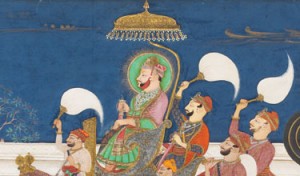
Museum operations are always in the black. Our general operating budget is separate from our debt servicing. Contributed income from supporters remains strong. Our recent gala for the Maharaja exhibition drew 630 guests, and netted more than $750,000—the most successful fundraising event in the museum’s history.
We instituted a $5 surcharge for recent special exhibitions, which allowed us to maintain a consistent level of earned income despite fewer visitors due to the reduced exhibition schedule. We are now able to eliminate the surcharge for our next two exhibitions. It’s important to remember that revenue from ticket sales only makes up 5-8% of our annual budget.
The loan facilitated by the City of San Francisco to restructure our debt is $97 million, over a 30-year term with a 4.6% fixed interest rate. The principle begins to amortize beginning with the second year of the loan, beginning February 2012.
4) Of the $20 million the museum must raise (stated in the 2011 agreement with the city), how much has been raised so far?
We’ve hired a national capital campaign consulting firm to help us determine the scope of a fundraising campaign, one that potentially goes beyond the required $20 million. A larger campaign would allow us to strengthen our endowment, plus pursue new programs. The consulting firm will complete its planning study early this year. Our partners at City Hall have been kept up to date on this plan.
5) So many museums around the U.S. are expanding their Asian art offerings – we’ve seen several terrific special exhibitions of late, as well as expanding permanent collections – to respond to population change. What can the Asian Art Museum offer that they don’t?
That’s the question we asked when developing our approach to contemporary art. What can we offer that no one else can? The answer came back to our collection. While many museums have Asian offerings, our museum is one of the few that can present its pan-Asian collection as a comprehensive whole, using standard nomenclature, with themes and storylines that run throughout the museum’s galleries. This comprehensive presentation makes the collection comfortably accessible, providing a rich experience to all museum visitors—from novice to connoisseur to scholar.
We are uniquely positioned to juxtapose, compare, inform, and tell stories with artworks past and present. Our aim is to highlight interconnectivity across time and place, connecting our visitors with Asian art and culture in new, engaging ways. This is what makes our upcoming exhibition, Phantoms of Asia, so compelling, and such a great example of the revitalized Asian Art Museum.

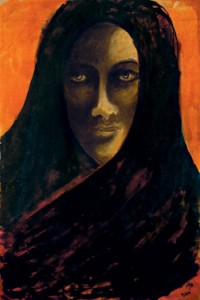
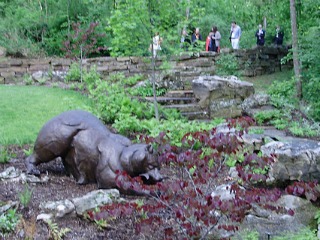 Noteworthy and, for the most part, laudable. Perhaps noting them will help counter the
Noteworthy and, for the most part, laudable. Perhaps noting them will help counter the 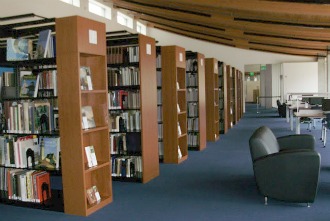 Next, the setting: Although I haven’t traversed all of the trails on the land surrounding the museum, I have on my two visits been able to walk some of them. They are lovely on their own, and while some large-scale sculptures sit on the premises (as above, Shore Lunch by Dan Ostermiller), they are sparse — so far — leaving plenty of room for nature. The building itself, which has several awkward features, does sit well in the ravine, relating to the terrain around it. Nice choice.
Next, the setting: Although I haven’t traversed all of the trails on the land surrounding the museum, I have on my two visits been able to walk some of them. They are lovely on their own, and while some large-scale sculptures sit on the premises (as above, Shore Lunch by Dan Ostermiller), they are sparse — so far — leaving plenty of room for nature. The building itself, which has several awkward features, does sit well in the ravine, relating to the terrain around it. Nice choice.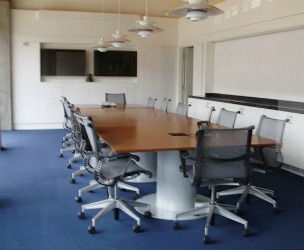 And forget the uncomfortable furniture found in many libraries — Crystal Bridges offers comfortable chairs, desks and computers. Books and art periodicals have also been placed between galleries, allowing visitors to rest, to take a breather, in little lounges before taking in the next tranch of art.
And forget the uncomfortable furniture found in many libraries — Crystal Bridges offers comfortable chairs, desks and computers. Books and art periodicals have also been placed between galleries, allowing visitors to rest, to take a breather, in little lounges before taking in the next tranch of art.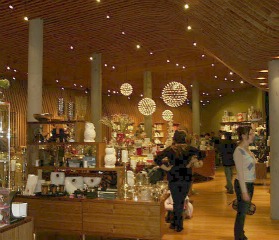 Crystal Bridges has a museum store — and a good one, very handsomely designed by Marlon Blackwell, as the photo at left attests –but it is not placed obnoxiously in front of the exit, so that all visitors must pass through it.
Crystal Bridges has a museum store — and a good one, very handsomely designed by Marlon Blackwell, as the photo at left attests –but it is not placed obnoxiously in front of the exit, so that all visitors must pass through it.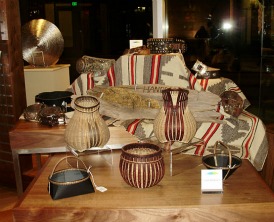 The museum also contains an auditorium, or, as it terms it, a “Great Hall” for lectures, concerts, films and other events — the one place I could not enter on either of my visits. It wasn’t finished last spring (there was only a hole in the ground then) and it was being set up for a concert when I visited in early December. The guard could not be persuaded to let me have a brief look.
The museum also contains an auditorium, or, as it terms it, a “Great Hall” for lectures, concerts, films and other events — the one place I could not enter on either of my visits. It wasn’t finished last spring (there was only a hole in the ground then) and it was being set up for a concert when I visited in early December. The guard could not be persuaded to let me have a brief look.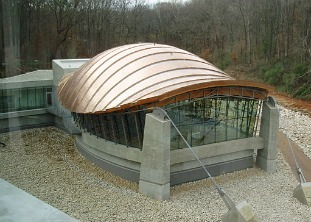 The hallway linking the main part of the museum to the Great Hall contains another admirable feature: the “community showcase.” Display cases have been inset in the walls, and area museums have been invited to place small displays drawn from their collections on view. This way, visitors to Crystal Bridges are exposed to other cultural institutions in the area, and they benefit from free publicity. Nice idea. The final photo, below, shows one of them currently on view. (Apologies for the poor picture quality. I was snapping during evening hours, which required a flash, and taking the pictures as museum visitors walked along the wall. I had to click fast.)
The hallway linking the main part of the museum to the Great Hall contains another admirable feature: the “community showcase.” Display cases have been inset in the walls, and area museums have been invited to place small displays drawn from their collections on view. This way, visitors to Crystal Bridges are exposed to other cultural institutions in the area, and they benefit from free publicity. Nice idea. The final photo, below, shows one of them currently on view. (Apologies for the poor picture quality. I was snapping during evening hours, which required a flash, and taking the pictures as museum visitors walked along the wall. I had to click fast.)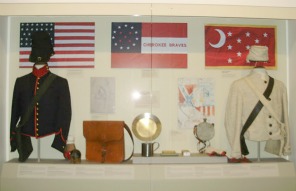 And did I mention the iPods? Visitors, upon surrender of a driver’s license or credit card, listen to guides about the collection on iPods, with Walton, museum director Don Bacigalupi and various curators providing commentary or dialogue for about two dozen works of art on view.
And did I mention the iPods? Visitors, upon surrender of a driver’s license or credit card, listen to guides about the collection on iPods, with Walton, museum director Don Bacigalupi and various curators providing commentary or dialogue for about two dozen works of art on view.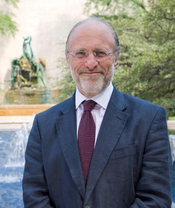 We wait for the next move: either Cuno (left) is going to take the reins of the museum himself,
We wait for the next move: either Cuno (left) is going to take the reins of the museum himself, 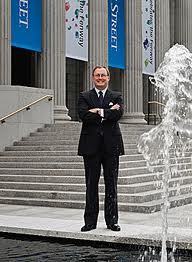 Ok, he’s “acting” director of the Art of Europe, and the email says that Rogers (right) will rely on the team assembled by Shackelford. By way of explanation, it said that the museum plans to open new Art of Europe galleries, greatly expanded when the Art of the Americas galleries moved to their own wing last year, next fall. There’s simply no time, the museum said, to recruit someone and make all the acquisitions, exhibition plans, gallery designs and reinstallations, in time.
Ok, he’s “acting” director of the Art of Europe, and the email says that Rogers (right) will rely on the team assembled by Shackelford. By way of explanation, it said that the museum plans to open new Art of Europe galleries, greatly expanded when the Art of the Americas galleries moved to their own wing last year, next fall. There’s simply no time, the museum said, to recruit someone and make all the acquisitions, exhibition plans, gallery designs and reinstallations, in time.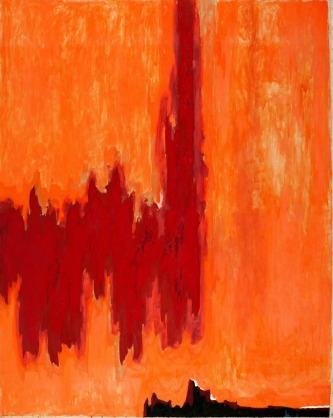 I’m sure many people will visit at first. But it’s an open question whether Still’s art has the staying power, whether there’s enough interest in his works, enough variety in his works, to keep people coming. Last week’s auction,
I’m sure many people will visit at first. But it’s an open question whether Still’s art has the staying power, whether there’s enough interest in his works, enough variety in his works, to keep people coming. Last week’s auction, 